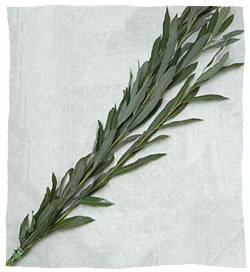The month of Tishrei in Judaism is like intensive grad school classes- all the fun is really packed in to a short amount of time. In this case, three weeks of more or less non-stop chagim, featuring Rosh Hashana, Yom Kippur, Sukkot, Shmini Atzeret, and Simchat Torah, will come to a conclusion as we usher in Shabbat this Friday.
The real good stuff waited until the end, though. If you were lucky enough to be a Jewish professional with the day off, or have all the chagim off at your job, perhaps you went to temple on Sukkot last Thursday and/or Friday and participated in a mass lulav and etrog wave-fest during the Hallel service. Walking into the sanctuary as everyone is shaking the lulav and singing the Psalms of Hallel is a fairly striking, and fragrant, prayer experience, and if you missed it this year I would recommend checking it out in 5772.
But while shaking the lulav is fun, there’s something else which you might find more interesting: the havatot aravot, the beating of the willow branches, into the ground on Hoshanah Rabbah, which falls on the 21st of Tishri (or in the vernacular, this Wednesday). It is traditional to process around the bimah seven times reciting Hoshanot (penitential prayers), after which willow branches are taken from the lulavim and beaten into the ground three or more times.
While the origin of this practice is murky (see this article for a lengthy discussion), there is more than a little evidence that the whole lulav-shaking business is a glorified prayer for rain, as the rattling of the different branches sounds like rainfall, and that the willow beating of Hoshana Rabbah is meant to remind us of the falling of rain on leaves.
In certain circles that argument may be challenged, or indeed refuted, by those who hold that we shake the lulav in all directions to indicate that God is everywhere, or offer up another spiritual explanation for the practice. While I fully embrace these additional layers of meaning placed on the rituals of lulav, I find it exceedingly likely that the foundation for these practices was in fact agricultural, and very practical.
Our forefathers in the land of Israel were as reliant on the natural cycle of the seasons and rainfall at its proper time as any other nation of farmers, and the supplications for dew (the Tal prayer at Pesach) and rain (the Geshem prayer at Sukkot) only reinforce the fact that Jews absolutely, necessarily, systematically, and passionately prayed for rain in days of old. And, in fact, we still do it today. Next time you catch yourself saying mashiv haruach u’morid hagashem (“who causes the wind to blow and the rain to fall”) during the Amidah or reading about Af-Bri, the angel of rain, during the Geshem prayer, you are going back to the basics of Judaism as it was practiced in its most authentic, and awe-filled fashion, with reverence for natural world and its unpredictability.
So grab a lulav and beat those willows into smithereens on Wednesday- at the very least you’ll have a fairly interesting and aggression-releasing experience.
This post has been contributed by a third party. The opinions, facts and any media content are presented solely by the author, and JewishBoston assumes no responsibility for them. Want to add your voice to the conversation? Publish your own post here. MORE



